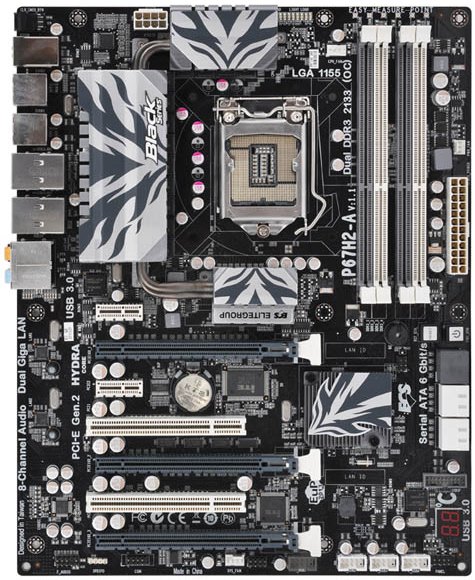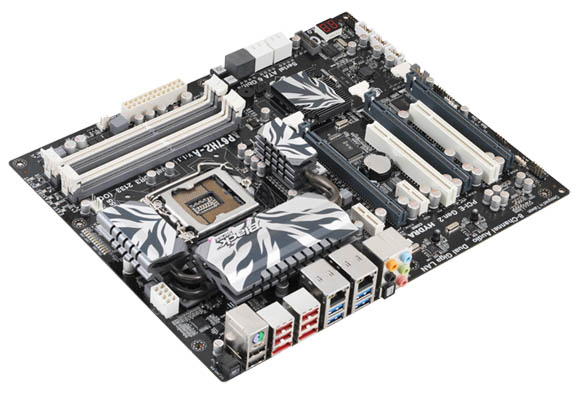ECS P67H2-A Review: A visit back to Lucid's Hydra
by Ian Cutress on July 21, 2011 9:00 AM EST- Posted in
- Motherboards
- Lucid
- P67
- ECS
If you remember back to October 2008, there were distinct murmurings about Hydra - an encompassing hardware and software solution to bring multiple GPUs together to act as one. Then, in January 2010, Ryan tested the Hydra chip, with the end result being: more development required. In my hands is the ECS P67H2-A, the latest board to include the Hydra solution. Armed with the latest version of the Hydra software too, I'm here to review this board, to see if it works as a suitable P67 solution, and if Hydra has anything to offer.
In terms of the P67H2-A itself, there are still quite a few areas that need polishing in order to improve the end user experience. There are BIOS issues relating to usability; there's a serious overclocking issue in the case of multithreading over 4.4 GHz, and the Hydra solution still isn't what we want (but you could say it's getting there, possibly). Out of the box, very few people would have issues. But it's when you get into the meat of the product where some slightly uncomfortable ridges occur, which other competitors have potentially worked on to get the better product.
Visual Inspection
The P67H2-A is a Black Series model from the ECS line-up, which means it gets the Black Series treatment - the silver, black and grey livery makes its way onto the PCB, all the slots and connectors, and the power delivery heatsink at least looks styled. The heatsink is a dual copper heatpipe design, which ECS states gives a 15-20ºC reduction in PWM temperature.

Along the top we find a 2x4-pin 12 V CPU power connector, and a series of lights indicating how many of the power phases are being utilised under different CPU loads. Next to this is a 4-pin CPU fan header – one of only three fan headers on the board (a PWR on the other side of the DIMM slots, and a SYS at the bottom of the board). Having only three fan headers on a high end board is rather shocking. Beyond the CPU fan header above the DIMM slots are voltage read points for vCore, DIMM, IMC, PCH and PLL – these require direct contact rather than easy slot in connectors, and given my experience of overclocking below, not required.
Working down the right hand side of the board, beyond the four DDR3-2133 (OC) memory slots, are onboard power and reset buttons. The PCH provides the standard two SATA 6 Gbps and four SATA 3 Gbps ports, all supporting RAID 0, 1, 5 and 10. It is odd not to find another controller provided on this board to give more internal SATA ports, given that so many others at this price range typically have another two SATA 6 Gbps ports provided by a controller. Instead, we have a controller for the eSATA 6 Gbps ports on the rear I/O panel.
Underneath this is a USB 3.0 port, which in my eyes is in a very odd place – this is a Hydra board, designed to aid multi-GPU situations. Yet if I use two medium level GPUs (e.g. 5850s at 9.5 inches long) in the appropriate slots, this obscures the USB 3.0 header completely. This seems to be an oversight in ECS’ design. Further below this port is a debug LED, which should according to the documentation double up as a ‘live’ temperature monitor after POST - however, this doesn't happen. Also of note is that this board doesn’t have a screw hole in the bottom right, for affixing the board to a case – a hole is there, but it’s neither in the right place nor the right type.
Underneath the heatsinks, this board contains a Hydra 200 chip. This chip is providing two important functions on this board – to serve as a bypass to requiring SLI certification, and also like an NF200 by organising extra PCIe lanes. As a result, the three full length PCIe x16 slots will run at x16/x16/x0 or x16/x8/x8 depending on if two or three graphics cards are used. Like the NF200, we expected this to result in a small decrease to performance compared to true x16/x16 native chipset implementations, but there may also be associated overhead in using the Hydra hardware (as well as the software). I examine the Hydra results in detail later in the review.

The PCIe layout itself is a mix of good and bad, using an x1, x16, x1, PCI, x16, PCI, x16 configuration – however the first x1 can be limited by the heatsink in terms of width, stalling any wide PCIe x1 cards. The only full length x1 will be blocked by any dual slot GPU. If the top two PCIe x16 slots are populated with GPUs, then the user could use the bottom PCIe x16 slot for the x1 card, however I’m unsure as to whether the slot would run in x8 mode (as all the PCIe are populated) or in x0 mode (because the GPUs are in the first two PCIe x16). It can be very hard to organise a tri-GPU motherboard and please everyone in this regard.

The back panel is a fairly reasonable layout of what would cover most people – a PS/2 port for mouse or keyboard, six USB 2.0 ports, four USB 3.0 ports (NEC controller), dual gigabit Ethernet (Realtek) which supports Teaming, a clear CMOS button, 8-channel audio jacks (Realtek) and an optical S/PDIF output.

















22 Comments
View All Comments
MWilliamson - Thursday, July 21, 2011 - link
An excellent review Ian; I'm impressed by how many combinations you tested under Hydra. While I'm currently not looking to build another system, I have found Hydra to be an interesting concept, and I'm waiting for it to mature to the point where it is valid for all configurations.What I wished to comment on though, was your comment in the Gaming Benchmarks:
"Metro 2033 is the Crysis of the DirectX 11 world (or at least until Crysis 2 is released)..."
Crysis 2 HAS been released, and has been available since April. Granted at the time of release it did not support DirectX 11, due largely in part to it being launched simultaenously on PC and consoles, a recent patch (released June 27th) has added its DirectX 11 feature set, and another patch increased the texture quality for PC gamers, both of which are actually optional, free upgrades. The most recent version, 1.9, also added a demo level which can be run via the in-game console; personally I have no experience with that side of things, since I played through for the storyline, but it is there, and I'd imagine its something you could add to your benchmarking suite, should it suit whatever your requirements are.
IanCutress - Thursday, July 21, 2011 - link
Many thanks on the update :) Not had much time to play games recently, but at some point I want to update the GPU drivers in my reviews also. Updating GPU drivers essentially removes all previous GPU results, so it might be worth having a look at the games I test as well at the same time.Ian
MWilliamson - Thursday, July 21, 2011 - link
You're most welcome, I had thought that was a possibility :)Igen - Thursday, July 21, 2011 - link
Hard to tell from the pics, but are those heatsinks riveted on? Would make mods/repairs difficult.DanNeely - Thursday, July 21, 2011 - link
The southbridge sink has what look like plastic fasteners; I'd assume they're pushpins of some sort. The moftset/etc sinks are harder too tell because of the angle and not being perfectly in focus, but if you look at the fastener in the lower right on the 5th pic the recessed area shows two indents that look like they're in the right spots to be part of a philips head which is otherwise out of sight. A high resolution vertical image/bottom image would really help.Uritziel - Friday, July 22, 2011 - link
MOFTSET lol! I'm going to start saying that :)Death666Angel - Thursday, July 21, 2011 - link
The green color of the ECS mainboard bars in the graphs for gaming makes little sense here, because then we don't know which resolution was used, as the resolution is identified as the colors. Though of course the higher resolution has most likely the lower fps numbers, it still looks odd. :-)Good review though!
HangFire - Thursday, July 21, 2011 - link
You got 3? Wow. My old ECS C2D board had one (two if you count the CPU).ECS has really moved up over the years.
fausto412 - Thursday, July 21, 2011 - link
this solution is junk.dhiiir - Friday, July 22, 2011 - link
I believe that the best motherboard can be ruined with a terrible BIOS or UEFI. UEFI is pretty cool, but if you can't make a good text only implementation, how the hell are you going to make a passable GUI? I'm perfectly happy with a well designed text based UEFI, but I will admit that as much time as I spend with BIOSs and UEFIs, Asus' slick GUI system is clearly in a class by itself. If I were new to the game, I would want something like that on my first build. There just isn't an excuse for terrible BIOS/UEFIs in the year 2011.I like online shopping,but don't know where have a good store to buy . I have a friend said that a shop is very good. -.www.upsfashion.com- I went. Really good. Things are cheap, fashion,. Owner has a good attitude. I am really happy to buy things there.